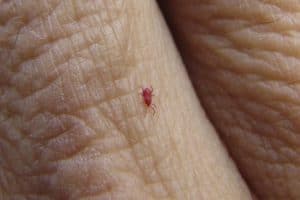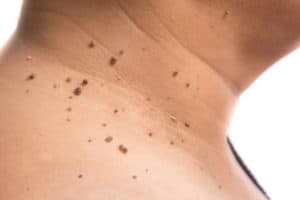Rashes are very common with babies. Often, the rash is a mild small red patch here and there. However, there are many times when a baby’s rash could be more serious. But how to tell when it is more serious? When to be concerned about a rash on a baby?
You should be more concerned with a rash on a baby if the baby has the following symptoms:
- Fever
- Colds
- Cough
- Swollen neck glands
- Rashes that do not go away after a long period of time
- Lack of appetite
- Widespread rashes accompanied by fever
If you’re in doubt, it’s best to visit a doctor to get a more solid answer as to what the rash is and how to treat it. Rashes are very common with babies, but if it is not going away, getting worse, accompanied by more problematic symptoms, or just plain making you lose sleep out of concern, then take your little one to the doctor.
Read on to learn more about when to be concerned about a rash on a baby and how to tell the difference between different types of baby rashes.
When to Be Concerned About a Rash on a Baby?
Baby skin is soft, delicate, and prone to various harmless rashes that do not require any treatment. However, there are cases where a rash should be more concerning. Concerning because it means that if the rash is not tended to by a doctor, then the baby could be left with more pain and discomfort if you don’t see a doctor.
Below, I’ll list types of rashes that should give rise to concern and therefore should be treated by a doctor.
1. Petechiae Rash (Also Referred to as Meningococcal Rash)

This kind of rash appears as a red or purple irritation or patch on your child’s skin. A test called a glass test can be performed in order to give you an idea of whether the patch is indeed a meningitis rash.
Use a glass to press the area with blotches. If the blotches remain red even after pressing, then the rash on your child must be a meningitis rash. Other symptoms that accompany this kind of rash are fever, drowsiness, lack of appetite, and sensitivity to light. So, if your baby has all these symptoms, then you should seek out medical attention. Babies from three to six months old are prone to this life-threatening bacterial infection.
2. Blister Rash
Blisters that are widespread on your child’s body should be considered a serious sign. This might be caused by an infection or a drug. One example of a syndrome with this kind of symptom is Stevens-Johnson Syndrome.
3. Purpura Rash
Purpura literally means bleeding into the skin. It appears to be large, purple, or dark red spots caused by a bacterial bloodstream infection. Rocky Mountain Spotted Fever has these symptoms.
4. Measles
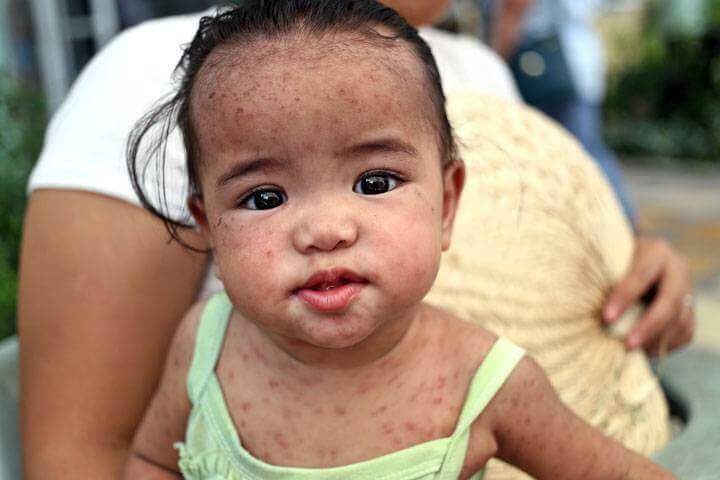
Your child might have measles if she/he has colds, cough, watery eyes, mouth ulcer (white spots inside their mouth), red patches on the skin. Again, if your child has all these symptoms, it is better to seek out medical attention. You should also know that measles is contagious even after the rashes disappear after a week.
5. Scarlet Fever

Scarlet fever, which is caused by Strep bacteria, can be accompanied by symptoms such as sore throat, fever, rashes, and swelling of glands around the neck. The rashes start on the upper part of the chest, which spreads to the cheeks and also the lower part of the chest, then the stomach. This fever can be treated with antibiotics as prescribed by the doctor.
6. Chickenpox

The primary indication that your baby has chickenpox is the presence of fluid-filled blisters. The blisters may appear in one area of the baby’s body but may spread all over the body as time progresses. Chickenpox is also accompanied by a slight fever.
The blisters will heal after a week, but as these blisters dry up, itchiness can be felt. Scratching the dried-up blisters will cause scars, but these scars can easily be treated. However, if you feel that these blisters and fevers cause your child discomfort, then you should seek medical attention to help your child feel better during the healing process.
7. Eczema
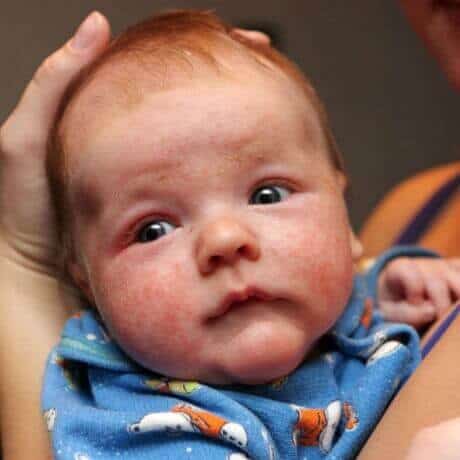
Babies’ skins are delicate; thus, they are prone to eczema, which appears as red, dry, and itchy rashes. Usually, these patches are found behind the ears, knees, elbows, and even in the creases of their neck.
The causes of eczema can be hard to figure out. It can be caused by soaps or detergents that are not appropriate for your baby’s sensitive skin, food or it can be caused by a sudden change in temperature. However, one way to keep your baby’s skin protected is through hydration.
The use of lotion, creams, and baths that are hypoallergenic, fragrance-free, and pH-neutral is advisable. It is better if you seek out the help of your pediatrician to better help you in choosing the said products.
When to be more concerned with baby eczema? When the eczema rash starts spreading, or you notice your baby is scratching too much, therefore, causing it to bleed or losing sleep. This is a more serious case of eczema and should be treated by a doctor.
8. Psoriasis
Psoriasis’ symptoms include red, dry, and scaly patches on the skin, which usually cover large areas of the skin. This skin condition can be experienced for a short period of time, but this could also be a long-term condition due to it being caused by an overactive immune system. Psoriasis can also be associated with diseases such as Crohn’s disease, diabetes, and heart disease.
9. Impetigo (Also Referred to as School Sores)
This sore is caused by bacteria which causes blisters with a yellow crust. This kind of sore is common for children between the ages of two to six. However, this should be your concern if your baby is a newborn since this condition is dangerous for them. Use prescribed antibiotic cream to treat this sore.
10. Ringworm (or Tinea)
The primary characteristic of ringworm that sets it apart from other skin conditions/diseases is the presence of a ring-like red rash on your baby’s skin. Usually, the areas affected by this infection are the baby’s scalp, feet, and groin.
As opposed to its name, it is caused by a fungus that can be treated with antifungal creams. Again, seek out the medical attention of a professional to help you out in choosing the best antifungal cream for your baby.
11. Hand, Foot, and Mouth Disease (Different from Foot and Mouth Disease from Farm Animals)
Hand, foot, and mouth disease cause rashes on the palms of the hands, mouth, and soles of the feet of your child. The rashes are accompanied by fever. It is better to make them stay at home since this is contagious. If the rashes do not go away after a week, then seek out medical attention for your child.
Still unsure when to be concerned about a rash on a baby? See the below video for insight from Dr. David Hill, a pediatrician from Cape Fear Pediatrics:
More Mild Baby Rashes That Are Less Concerning
Below are some of the types of rashes that are less concerning because they are milder and often go away on their own without treatment. It still doesn’t hurt to seek medical advice from a doctor for these rashes if you are overly concerned.
1. Heat Rash
Heat rash is caused by overheating. This is usually found on the chest, back, and creases of the neck. This will eventually disappear after transferring your child to a well-ventilated area.
2. Hives
Rashes that can be found commonly on the chest, stomach, back, throat, and limbs may also look like a mosquito bite. This can be caused by a virus or an allergic reaction. This can go away without any treatment. However, if this rash did not heal after a week, then seek medical attention for your child.
3. Molluscum Contagiosum
This kind of rash can appear after swimming in a pool with other people or by sharing towels with people. This could disappear after a month or so without treatment. However, if the healing did not occur, it is cause for concern, and you should seek medical attention.
4. Diaper Rash
50-60% of the babies are said to experience a diaper rash that usually causes discomfort, as indicated by the frequency of crying, agitation and restlessness, lack of appetite, change in sleeping pattern, and even less urination or more frequent bowel movement. Your baby has a diaper rash if their bottom is sensitive, or has the presence of redness, chafing, and flaking.
The causes of the diaper rash include bacteria, urine, friction, and a tight environment. You can use mild wipes or a warm and wet washcloth to clean your baby. Using a moisturizer can also help in preventing rashes. Make sure that the skin is dry before putting on a diaper. The diaper should not be put too tight and should be the right size for your baby. Also, it is better if you let your baby go without his/her diaper from time to time.
5. Baby Acne (Milia)
Baby acne refers to the acne present on your baby’s cheeks and nose, and this usually takes time before they disappear but generally does not need any treatment. It can be more concerning if the acne spreads all over the body, and therefore you should seek a doctor’s advice.
6. Erythema Toxicum
Newborn babies are the ones usually affected by these red blotches. These blotches can disappear without any treatment after a few days or weeks.
7. Roseola (Classic Rash)
This can be experienced by children between six months and three years of age. The rash appears to be pink, small, flat spots found on the chest and stomach, which last for one to three days. Prior to the appearance of rashes, your baby might experience three to five days of fever. This kind of rash is harmless and does not need any treatment.
Conclusion – When to Be Concerned About a Rash on a Baby?
Take note to all the parents out there – if your baby’s rashes are accompanied by the following symptoms, then you should be concerned about the rash and should immediately seek medical attention.
- Fever
- Colds
- Cough
- Swollen neck glands
- Rashes that do not go away after a long period of time
- Lack of appetite
- Widespread rashes accompanied by fever
Treatment
It is absolutely necessary to use products and medicine prescribed by your pediatrician. The parents should also be careful when giving their baby medicine because they might be allergic to some of them. If you’re unsure about your baby’s condition, then it’s better safe than sorry to see a doctor.
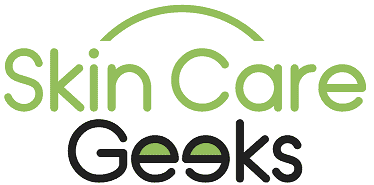
![Read more about the article How to Get Dead Skin Off Lips [6 Natural Remedies]](https://skincaregeeks.com/wp-content/uploads/2021/04/how-to-get-dead-skin-off-lips-300x200.jpg)
